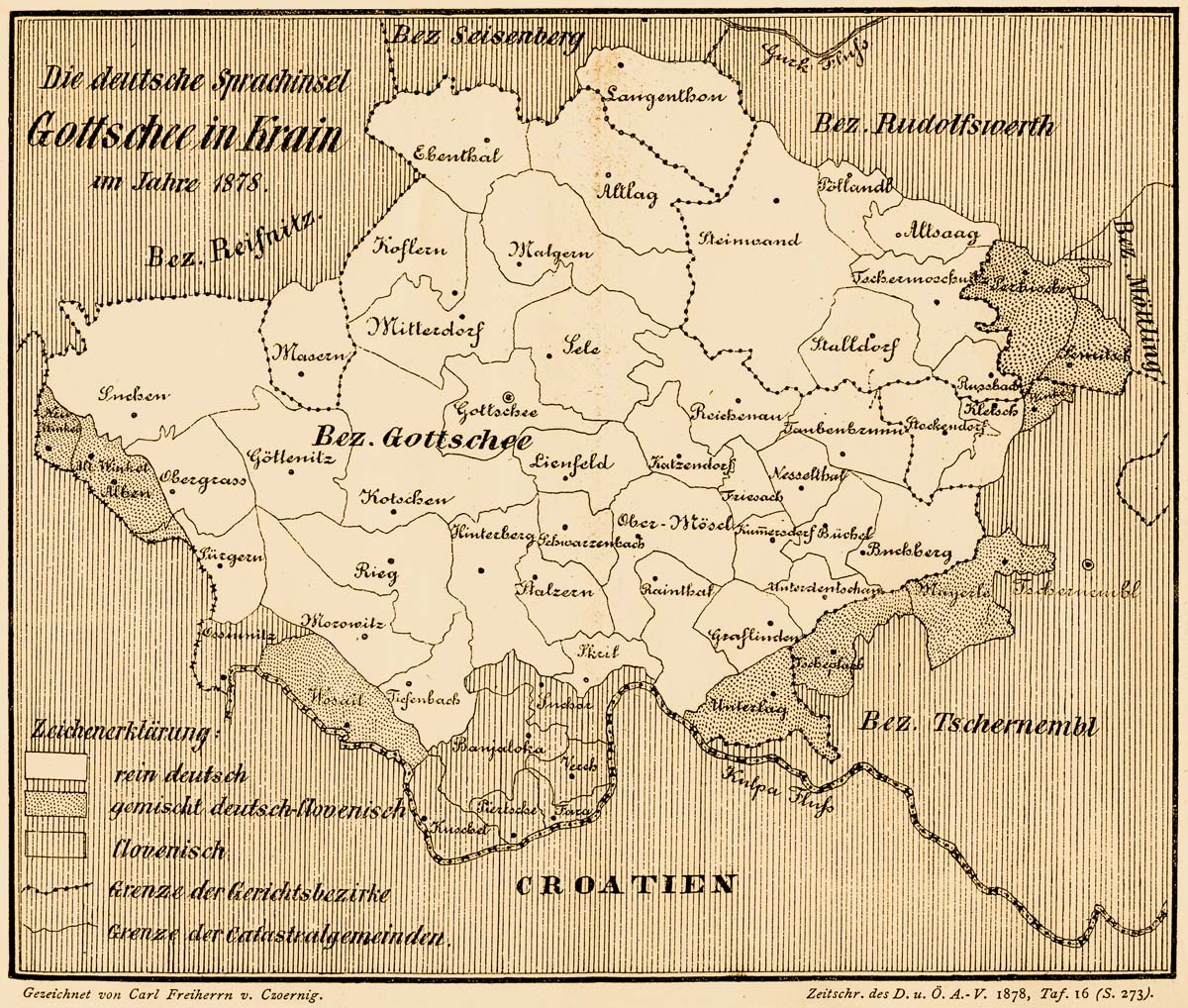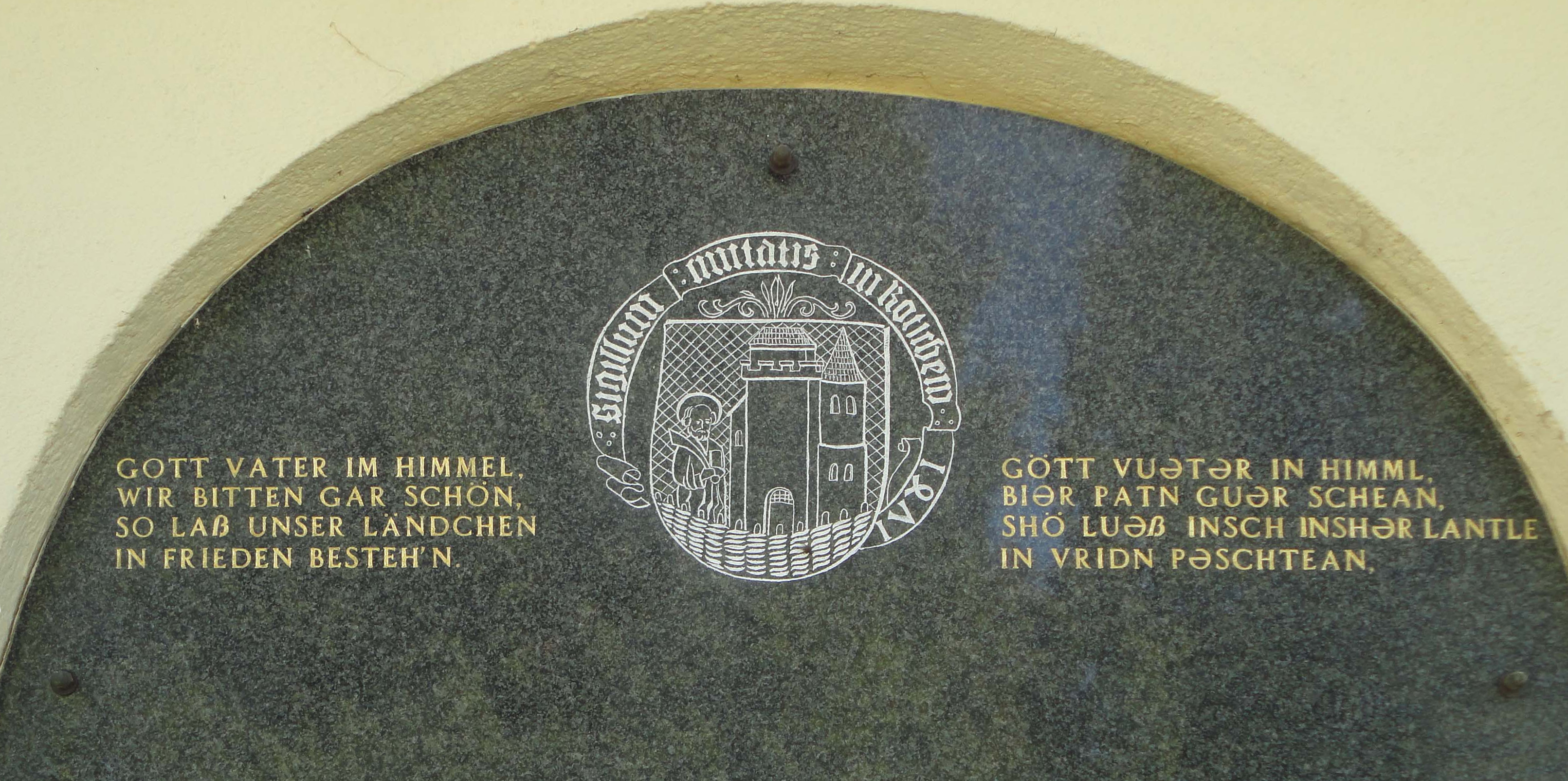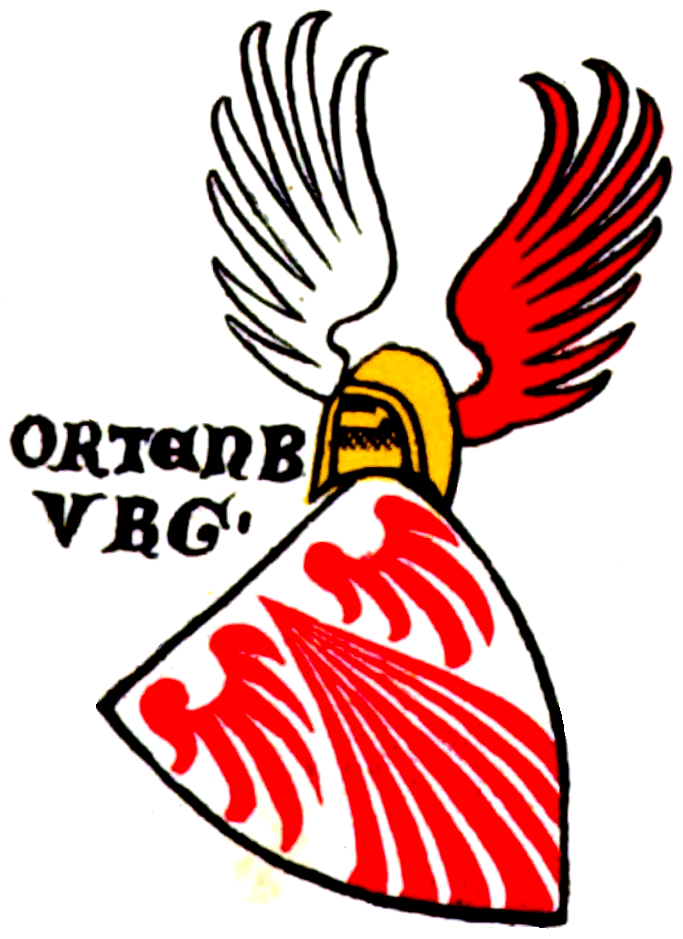|
Gottschee
Gottschee (, sl, Kočevsko) refers to a former German-speaking region in Carniola, a crownland of the Habsburg Empire, part of the historical and traditional region of Lower Carniola, now in Slovenia. The region has been a county, duchy, district, and municipality during various parts of its history. The term often also refers to the entire ethnolinguistic enclave regardless of administrative borders. Today Gottschee largely corresponds to the Municipality of Kočevje. The original German settlers of the region are called Gottschee Germans or Gottscheers, and their German dialect is called Gottschee German or Gottscheerish. Geography The Gottschee enclave encompassed a roughly oval-shaped area between 45° 46′ N and 45° 30′ N, and between 14° 36′ E and 15° 9′ E. Geographers divided the enclave into seven regions based on valleys (from west to east): * The Suchen Plateau () in the extreme west, with the (pre-1933) municipalities of Obergras and Suchen; * The Back Distric ... [...More Info...] [...Related Items...] OR: [Wikipedia] [Google] [Baidu] |
Gottscheerish
Gottscheerish (''Göttscheabarisch'',Maridi Tscherne: Wörterbuch Gottscheerisch-Slowenisch. Einrichtung für die Erhaltung des Kulturerbes Nesseltal, Koprivnik/Nesseltal 2010. german: Gottscheerisch, sl, kočevarščina) is an Upper German dialect which was the main language of communication among the Gottscheers in the enclave of Gottschee, Slovenia, before 1941. It is occasionally referred to as Granish or Granisch in the United States (< German ''Krainisch'' 'n'), a term also used for Slovene. Today there are only a few speakers left in Slovenia and around the world. Language history Gottscheerish belongs to Southern Bavarian within the[...More Info...] [...Related Items...] OR: [Wikipedia] [Google] [Baidu] |
Gottscheers
Gottscheers are the German settlers of the Kočevje region (a.k.a. Gottschee) of Slovenia, formerly Gottschee County. Until the Second World War, their main language of communication was Gottscheerish, a Bavarian dialect of German. Origins They first settled in Carniola around 1330 from the German lands of Tyrol and Carinthia and maintained their German identity and language during their 600 years of isolation. They cleared the vast forests of the region and established villages and towns. In 1809, they resisted the French annexation of the territory in the Gottscheer Rebellion. With the end of the Habsburg monarchy in 1918, Gottschee became a part of the new Kingdom of Yugoslavia. The Gottscheers thus went from part of the ruling ethnicity of Austria-Hungary (and the ruling group in the estates of the province of Carniola itself) to an ethnic minority in a large Slavic state. With the onset of the Second World War and the 1941 Axis invasion of Yugoslavia, their situati ... [...More Info...] [...Related Items...] OR: [Wikipedia] [Google] [Baidu] |
Kočevje
Kočevje (; german: Gottschee; ''Göttscheab'' or ''Gətscheab'' in the local Gottscheerish dialect; it, Cocevie) is a city in the Municipality of Kočevje in southern Slovenia. It is the seat of the municipality. Geography The town is located at the foot of the Kočevski Rog karst plateau on the Rinža River in the historic Lower Carniola region. It is now part of the Southeast Slovenia Statistical Region. The Rinža River flows through the town. Lake Kočejve, a former open-pit coal mine, lies northeast of the town center. Climate Kočevje features a humid continental climate (''Dfb''/''Cfb''). Name Kočevje was attested in written sources in 1363 as ''Gotsche'' (and as ''Gotsew'' in 1386, ''Kotsche'' in 1425, and ''propre Koczeuiam'' in 1478). The name is derived from ''*Hvojčevje'' (from ''hvoja'' 'fir, spruce'), referring to the local vegetation. The initial ''hv-'' changed to ''k-'' under the influence of German phonology. Older discredited explanations inclu ... [...More Info...] [...Related Items...] OR: [Wikipedia] [Google] [Baidu] |
Principality Of Auersperg
} The House of Auersperg ( sl, Auerspergi or ''Turjaški'') is an Austrian princely family, which held estates in Austria and Tengen (in Baden-Württemberg, Germany). The princely family of Auersperg was a junior branch of the house of Counts of Auersperg from Carniola, one of the hereditary Habsburg duchies in what is now Slovenia. It rose to princely status in 1653 and after acquiring Tengen, they became immediate Princes of the Holy Roman Empire. The princes of Auersperg also held at various times the duchies of Münsterberg and Gottschee. Their territories were mediatised by Austria and Baden in 1806. The family is counted as high nobility. History Origins to early modern period The former '' edelfrei'' family was first mentioned as ''Ursperch'' in an 1162 deed issued by Duke Herman II of Carinthia at his residence St. Veit. Their ancestral seat was Turjak Castle (german: Burg Ursperg, later ''Burg Auersperg'') in the March of Carniola, according to an engraving on si ... [...More Info...] [...Related Items...] OR: [Wikipedia] [Google] [Baidu] |
Kočevske Poljane
Kočevske Poljane (; german: Pöllandl''Leksikon občin kraljestev in dežel zastopanih v državnem zboru,'' vol. 6: ''Kranjsko''. 1906. Vienna: C. Kr. Dvorna in Državna Tiskarna, p. 156–157.Ferenc, Mitja, & Gojko Zupan. 2012. ''Izgubljene kočevske vasi, vol. 2 (K–P)''. Ljubljana: Znanstvena založba Filozofske fakultete Univerze v Ljubljani, p. 224.) is a village in the Municipality of Dolenjske Toplice in Slovenia. The area is part of the historical region of Lower Carniola. The municipality is now included in the Southeast Slovenia Statistical Region. The village includes the hamlets of Gorica (german: Büchel or ''Büchel bei Pöllandl'') and Trnovec (or Trnje; german: Dornachberg). Name The name of the settlement was changed from ''Poljane'' to ''Kočevske Poljane'' in 1953. In the past the German name was ''Pöllandl''. History Pöllandl was a village settled by Gottschee Germans inside the Gottschee region until 1941. During the Second World War its original popula ... [...More Info...] [...Related Items...] OR: [Wikipedia] [Google] [Baidu] |
County Of Ortenburg
The Counts of Ortenburg (german: Grafen von Ortenburg) were a Graf, comital family in the mediaeval Duchy of Carinthia. Though they had roots in Duchy of Bavaria, Bavarian nobility, an affiliation with the Imperial County of Ortenburg, Imperial Counts of Ortenburg, a branch line of the Rhenish Franconian House of Sponheim, is not established.Hausmann, Friedrich (1994). "Die Grafen zu Ortenburg und ihre Vorfahren im Mannesstamm, die Spanheimer in Kärnten, Sachsen und Bayern, sowie deren Nebenlinien" in ''Ostbairische Grenzmarken - Passauer Jahrbuch für Geschichte Kunst und Volkskunde''. Nr. 36, Passau 1994. History Little is known about the reasons the Ortenburgs settled in the Carinthian Lurnfeld, Lurngau. No charters are available on the creation of the Burgruine Ortenburg, Ortenburg Castle on the northern slope of Mt. Goldeck above the village of Baldramsdorf, nor about the manner in which the Ortenburgs obtained their property. In 1072, one Adalbert of Ortenburg, probably a ... [...More Info...] [...Related Items...] OR: [Wikipedia] [Google] [Baidu] |
Gotenica
Gotenica (; in older sources also ''Gotnica'', german: Göttenitz,''Leksikon občin kraljestev in dežel zastopanih v državnem zboru,'' vol. 6: ''Kranjsko''. 1906. Vienna: C. Kr. Dvorna in Državna Tiskarna, p. 36.Ferenc, Mitja. 2007. ''Nekdanji nemški jezikovni otok na kočevskem''. Kočevje: Pokrajinski muzej. Gottscheerish: ''Gənize'' or ''In dr Gənizn''Petschauer, Erich. 1980. "Die Gottscheer Siedlungen – Ortsnamenverzeichnis." In ''Das Jahrhundertbuch der Gottscheer'' (pp. 181–197). Klagenfurt: Leustik.) is a settlement in the Municipality of Kočevje in southern Slovenia. The area is part of the traditional region of Lower Carniola and is now included in the Southeast Slovenia Statistical Region. Geography Gotenica is located in a clearing surrounded by wooded plateaus and hills: Mount Gotenica (''Goteniška gora'') to the west, with nearby Gotenica Mount Snežnik (''Goteniški Snežnik'', ) as its highest peak, the Big Mountain (''Velika gora'') chain to the north ri ... [...More Info...] [...Related Items...] OR: [Wikipedia] [Google] [Baidu] |
Slovenia
Slovenia ( ; sl, Slovenija ), officially the Republic of Slovenia (Slovene: , abbr.: ''RS''), is a country in Central Europe. It is bordered by Italy to the west, Austria to the north, Hungary to the northeast, Croatia to the southeast, and the Adriatic Sea to the southwest. Slovenia is mostly mountainous and forested, covers , and has a population of 2.1 million (2,108,708 people). Slovenes constitute over 80% of the country's population. Slovene, a South Slavic language, is the official language. Slovenia has a predominantly temperate continental climate, with the exception of the Slovene Littoral and the Julian Alps. A sub-mediterranean climate reaches to the northern extensions of the Dinaric Alps that traverse the country in a northwest–southeast direction. The Julian Alps in the northwest have an alpine climate. Toward the northeastern Pannonian Basin, a continental climate is more pronounced. Ljubljana, the capital and largest city of Slovenia, is geogr ... [...More Info...] [...Related Items...] OR: [Wikipedia] [Google] [Baidu] |
Mahovnik
Mahovnik (; in older sources also ''Mošvald'';''Intelligenzblatt zur Laibacher Zeitung'', no. 141. 24 November 1849, p. 26 german: Mooswald,''Leksikon občin kraljestev in dežel zastopanih v državnem zboru,'' vol. 6: ''Kranjsko''. 1906. Vienna: C. Kr. Dvorna in Državna Tiskarna, p. 36. in older sources also ''Moschwald'') is a settlement on the left bank of the Rinža River, immediately northwest of the town of Kočevje in southern Slovenia. The area is part of the traditional region of Lower Carniola and is now included in the Southeast Slovenia Statistical Region. History Mahovnik was the first settlement in Gottschee attested in written sources. It was named in a letter from Patriarch Bertram to Count Oton von Ortenburg on 1 September 1339.Tschinkel, Wilhelm. ''Gottscheer Volkstum in Sitte, Brauch, Märchen, Sagen, Legenden und anderen volkstümlichen Überlieferungen.'' Ljubljana: ZRC, p. 607. At the time, it also included the territory of present-day Kočevje Kočev ... [...More Info...] [...Related Items...] OR: [Wikipedia] [Google] [Baidu] |
Lower Carniola
Lower Carniola ( sl, Dolenjska; german: Unterkrain) is a traditional region in Slovenia, the southeastern part of the historical Carniola region. Geography Lower Carniola is delineated by the Ljubljana Basin with the city of Ljubljana to the northwest, by the Kolpa River and the border with Croatia with the Gorjanci Mountains to the south and southeast, by the Sava River to the north and northeast, and by Mount Krim, the Bloke Plateau, and the Potok Plateau ( sl, Potočanska planota) to the west. The southernmost region down to the border with Croatia on the Kolpa River is called White Carniola and usually considered part of Lower Carniola. Within the Kočevje Rog karst plateau, the mountains reach an elevation of up to . The historic centre of Lower Carniola is Novo Mesto, and other towns include Kočevje, Grosuplje, Krško, Trebnje, Mirna, Črnomelj, Semič, and Metlika. History In the 17th century, the Habsburg duchy of Carniola was internally divided into th ... [...More Info...] [...Related Items...] OR: [Wikipedia] [Google] [Baidu] |
Municipality Of Kočevje
The Municipality of Kočevje (; sl, Občina Kočevje) is a municipality in southern Slovenia. The seat of the municipality is the city of Kočevje. Today it is part of the Southeast Slovenia Statistical Region. In terms of area, it is the largest municipality in Slovenia. History In 1247 Berthold, Patriarch of Aquileia granted the area around Ribnica within the imperial March of Carniola to the Carinthian counts of Ortenburg. When the counts received further estates on the wooded plateau down to Kostel on the Kolpa River in 1336 from the hands of Patriarch Bertram, they called for German-speaking settlers from Carinthia and Tyrol. These Germanic people became known as the Gottscheers, and their dialect, Gottscheerish. Thousands of Gottscheers, and others, were accused of sympathy for or collaboration with the Axis Powers during World War II (such as the Slovene Home Guard), after the war. They, and typically their entire families, were summarily executed, thrown int ... [...More Info...] [...Related Items...] OR: [Wikipedia] [Google] [Baidu] |
Blatnik Pri Črmošnjicah
Blatnik pri Črmošnjicah (; german: Rußbach''Leksikon občin kraljestev in dežel zastopanih v državnem zboru,'' vol. 6: ''Kranjsko''. 1906. Vienna: C. Kr. Dvorna in Državna Tiskarna, p. 152.Ferenc, Mitja. 2007. ''Nekdanji nemški jezikovni otok na kočevskem''. Kočevje: Pokrajinski muzej, p. 4.) is a small settlement in the Municipality of Semič in Slovenia. It was inhabited by Gottschee Germans that were mostly expelled in 1941 during the Second World War. The area is part of the historical region of Lower Carniola. The municipality is now included in the Southeast Slovenia Statistical Region. Name Blatnik pri Črmošnjicah was attested in written sources as ''Ruespach'' in 1574. The toponym ''Blatnik'' is relatively common in Slovenia and generally refers to low-lying areas near water; it is also found as a hydronym and surname. The name is derived from the common noun ''blato'' 'mud; swamp, marsh', which is also the root of names like ''Blače'', ''Blatno'', and ''Blate ... [...More Info...] [...Related Items...] OR: [Wikipedia] [Google] [Baidu] |






